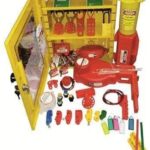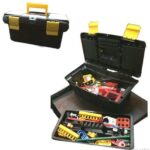Your list is empty, add products to the list to send a request
How to Check Fire Alarm Panel

24
Jul
A fire alarm system is only effective if it’s fully operational. That’s why it’s critical to know how to check fire alarm panel devices and ensure they’re functioning properly. A faulty panel could delay emergency response, cause system failures, or even risk lives.
In this guide, you’ll learn how to inspect, test, and maintain your fire alarm control panel. You’ll also understand what to look for, how often to check, and how to catch issues early—before they become real threats.
What Is a Fire Alarm Panel?
A fire alarm panel, or fire alarm control panel (FACP), is the central unit of your fire detection system. It receives signals from smoke detectors, manual call points, heat sensors, and sprinkler flow switches. When a potential fire is detected, the panel:
- Triggers audible and visual alarms
- Displays the alarm’s zone or device address
- Activates emergency systems like elevator recall or ventilation shut-off
- Notifies the fire brigade or a monitoring centre (if connected)
In short, it’s the brain of your fire safety system—and regular testing keeps it sharp.
Why It’s Important to Check Your Fire Alarm Panel
- Ensure immediate response in case of fire
- Identify faults early (wiring, device failure, battery issues)
- Comply with fire safety codes and insurance policies
- Avoid fines or shutdowns during audits or inspections
- Save lives and protect property
A non-working fire panel is worse than no fire system at all—it gives a false sense of security.
How Often Should You Check a Fire Alarm Panel?
To maintain fire safety standards, follow this frequency:
- Daily Check (Visual check of panel status and power supply)
- Weekly Test (Functional check of alarm system devices)
- Monthly Inspection (Battery and system component inspection)
- Annual Service (Certified technician inspection with full system test)
How to Check Fire Alarm Panel: Step-by-Step
Step 1: Visual Status Check
- Look at the panel display.
- Ensure the panel reads “Normal” (no active alarms or faults).
- Check that green LED for power is on.
- Confirm no yellow LEDs are indicating faults.
Step 2: Power Supply Inspection
- Confirm that the AC mains power is working.
- Test the battery backup system—disconnect mains briefly to ensure the panel runs on battery.
- Check for any low battery warning.
Step 3: Device Testing
Choose at least one detector or manual call point per zone and trigger it.
- Panel should receive the signal within seconds.
- The zone number or device address should appear on the panel.
- Sounders and visual alarms should activate.
- After confirming the system works, use the panel to reset it.
Step 4: Alarm Reset and Silence Functions
- Use the Silence button to stop the internal sounder (not external alarms).
- Use the Reset button to bring the panel back to normal mode.
- Make sure the alarm resets properly and no fault remains.
Step 5: Inspect Wiring and Connections
- Open the panel (if you are authorised) to inspect internal wiring.
- Look for loose wires, corrosion, or moisture damage.
- Make sure all terminals are tight and labelled.
How to Inspect a Fire Alarm Panel – What to Look For
Use this checklist when inspecting your panel:
- Power LED (green) is ON
- No fault or trouble indicators lit
- Alarm, Silence, and Reset buttons are responsive
- Panel is clean and dust-free
- Device labels match site layout
- Battery terminals are clean and tightly connected
- Event log is recording entries correctly (if available)
What Is Fire Alarm Testing?
Fire alarm testing involves checking the functionality of each component in your fire alarm system. This includes:
- Smoke and heat detectors
- Manual call points
- Alarm sounders and strobes
- Relay outputs
- Fire alarm panel responses
The goal is to simulate a fire condition and verify that the system responds correctly, alerts occupants, and resets afterward.
Testing ensures reliability and keeps your system ready to respond in real emergencies.
How to Test Fire Control Panel: Quick Guide
You can test your fire control panel with these steps:
- Activate a detector or call point (e.g. use smoke spray or press the break-glass point).
- Confirm that the panel shows the correct zone or device.
- Silence the internal buzzer after checking.
- Check that external alarms and sirens also activate.
- Use the Reset button to return the system to normal.
- Record test results in your fire safety log.
If your system is addressable (like the Avani Addressable Fire Alarm Control Panel), the panel will show exact device IDs and log data automatically.
Common Issues Found During Fire Alarm Panel Checks
- Faulty detectors or call points
- Loose wiring or corroded terminals
- Dead backup battery
- False alarms due to dust or insects
- Mislabelled zones
- Trouble light with no obvious fault
Catching these issues early can save time, money, and lives.
Frequently Asked Questions
1. What is fire alarm testing?
Fire alarm testing is the process of checking whether your fire alarm system detects fire conditions and responds properly. This includes triggering alarms, checking the panel’s response, testing reset functions, and ensuring devices are working.
2. How to inspect a fire alarm panel?
Inspect the display screen, power LED, fault indicators, and physical components like wiring and batteries. Look for corrosion, loose connections, or false alarm signals. Test buttons like Silence, Reset, and Drill to ensure full functionality.
3. How to test fire control panel?
Trigger a manual call point or detector. Check if the panel identifies the device and activates alarms. Silence and reset the panel once testing is complete. Document the test results for compliance and future tracking.
Recommended Panel: Avani Addressable Fire Alarm Control Panel (RAVEL)
For advanced safety and easy zone identification, choose a professional-grade system:
Avani Addressable Fire Alarm Panel
- Full LCD interface
- Digital addressability for pinpointing exact alarms
- Power backup included
- Ideal for offices, buildings, and industrial spaces
Final Thoughts
Knowing how to check a fire alarm panel isn’t just a technical task—it’s part of your responsibility to keep people and property safe. Regular checks ensure your alarm system is always ready to act when it matters most.
With the right tools, knowledge, and system—like the Avani Addressable Panel—you can protect what matters and respond to emergencies without delay.
Take Action Now
Ready to upgrade your fire safety system?
Order your Ravel Avani panel from Fire Supplies and ensure your building is protected with precision, reliability, and peace of mind.


























